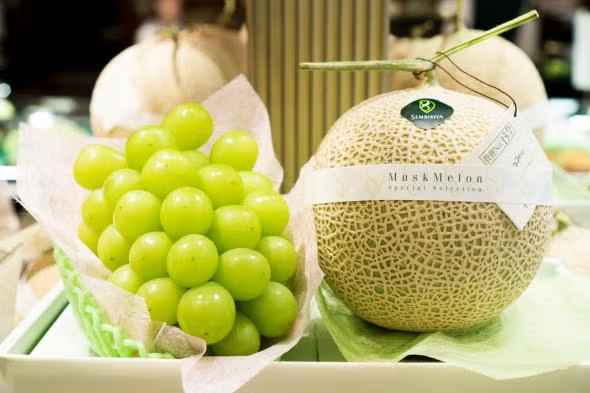During the Coronavirus (COVID-19) pandemic and economic recession in 2020, the share of U.S....
The World of Luxury Fruit: Does a $156 Melon Taste Sweeter?

Fruit may be a staple. It can also be a status symbol prized for flavor, rarity and appearance.
A $396 pineapple comes tucked into an ornate red box which unfurls like origami and is punched with breathing holes. A $156 melon, swaddled in foam netting, grew alone on a vine from which every other fruit was pruned, with the aim of making it extra sweet.
Luxury fruits, which have a long history in parts of Asia, are gaining popularity in the United States, as new varieties are being grown and imported, including those developed over several years by companies aiming to market unique-looking and unique-tasting produce. The $396 pineapple — trademarked as the Rubyglow for its red skin, and extremely limited — recently sold out in the United States within a matter of weeks.
Some of the fruits have long been given as gifts, especially in Japan and Korea. That trend is catching on in the United States, as is the taste for flawless berries and melons that travelers may have tried overseas, produce experts said. And as the luxury goods industry has grown, so too has the interest in luxury fruit, said Soyeon Shim, a scholar of consumer and financial behavior at the University of Wisconsin-Madison.
“The market has become much more global,” she said. Ms. Shim added, “you can buy anything you want.”
Eve Turow-Paul, an author and expert in global food trends, described luxury fruits as being among the “couture food experiences” through which people attempted to make value statements. “Over the last 10 years especially, global food culture has become homogenized,” she said. “How do you continue to one-up other people in this kind of food environment?”
In recent decades, unique produce — including the $156 melon, known as a Crown Melon; specialty grapes from South Korea prized for their large size and crisp texture; white strawberries from Japan; and mangosteens, a tropical fruit with soft white flesh — has been imported to the United States, said Robert Schueller, a spokesman for Melissa’s Produce, which describes itself as the largest distributor of specialty fruits and vegetables in the country.
The company’s attempts to introduce unfamiliar fruits to the American palate, however, have not always been successful, he added. The star apple, a deep purple fruit native to the Caribbean and Central America; the oca, a yam popular in New Zealand; and a square watermelon — which though it “cut like toast,” lacked a superior flavor — all failed to take off, Mr. Schueller said. (Melissa’s is now working with a grower in Costa Rica to develop a watermelon that is both box-shaped and sweet.)
For the vast majority of Americans, however, luxury fruits remain out of reach. The average household spends about $1,080 on groceries a month, according to a recent analysis of data from the Bureau of Labor Statistics. And even for those who can afford it, can a pineapple ever be worth the cost of a dishwasher?
“There’s no reason to ever spend $400 for one fruit,” said David Karp, a fruit researcher at the University of California, Riverside.
Mr. Karp, who is known for hunting down rare produce, said that while he had not yet sampled the Rubyglow, there was nothing in the pineapple’s patent to suggest it was far superior to common varieties. But in some cases, it was worth spending a more modest premium on the most delicious, seasonal produce, he added. “You can get mind-blowingly great fruit,” Mr. Karp said, “for $10 or $20 a pound.”
Here are some of the fanciest fruits available in the United States:
Designer Pineapples
The Pinkglow pineapple, grown in Costa Rica, was genetically engineered by Fresh Del Monte for its candy-pink flesh and low acidity. It was introduced in 2019 for about $50 and now costs up to $29, depending on its size.
Coddled Strawberries
A pound of nonorganic strawberries usually costs just a few dollars. A single luxury berry can cost that much, or even more — up to about $29 each.
Crown Melon
The Crown Melon, fragrant and sweet, is a specialty muskmelon from Shizuoka Prefecture in Japan, which has a warm, sunny climate. Each vine is pruned to grow just a single fruit, concentrating the melon’s flavor. The melon was only recently approved for import into the United States, and can cost up to $156 per fruit.
EDITOR’S TAKE:
At a time where over two-thirds of Americans are living paycheck-to-paycheck, luxury fruit is probably not on their shopping list. In fact, not many people can afford such prices for a piece of fruit. Also, consider the fact that it probably doesn’t even taste better. I do know from my travels to the far east, that many people consider such products a suitable gift for Christmas or New Years. If this is in your wheelhouse, more power to you – enjoy. For most of mere mortals this is a little beyond what they wish to pay. I, personally, like regular strawberries from the local supermarket with a little shortcake and some whipped cream, thank you very much!








